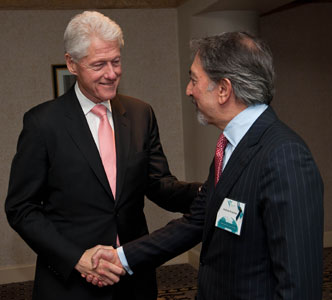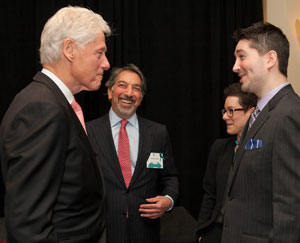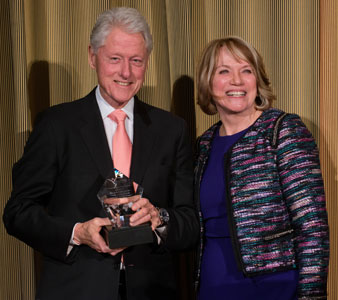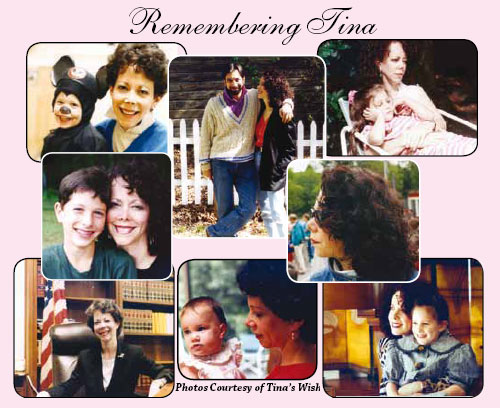

 REGISTER TODAY!
REGISTER TODAY!

Magazines serving the communities of Northern Westchester


 REGISTER TODAY!
REGISTER TODAY!
By Grace Bennett • Photos by Beatrice Moritz

The story of The Honorable Tina Brozman Foundation for Ovarian Cancer Research (better known as Tina’s Wish) began well before President Bill Clinton generously took to the podium at the Waldorf Astoria this spring to accept the inaugural Tina’s Wish Global Women’s Health Award.
Of course, it was certainly monumental to the efforts of Tina’s Wish, and to Tina’s family, the Brozmans, to have Bill Clinton, their neighbor and 42nd President of the United States, at different junctures express a profound optimism about the increasing availability of state of the art cancer care but also lament the lack of early detection systems. Most importantly, President Clinton would continuously commend Tina’s Wish as a unique foundation for its remarkable efforts toward creating a collaborative research effort that appears to offer such a promising chance at finding an early test for the detection of ovarian cancer.
Clinton: “Thanks to this consortium we have a chance to solve the early detection riddle…We can make it so that 100 percent of people recover and live normal lives…it is the finest network of creative and intelligent minds imaginable.”
The story truly begins, however, with one cancer victim’s acute frustration–Tina Brozman’s. “Recently, I was asked yet again if I’m angry about having cancer,” Tina wrote (about six months before she passed). “I’m not angry about the disease. But I am dismayed and yes, angered that it wasn’t diagnosed sooner, when perhaps the treatments would have been more effective.”
Clinton: “Ovarian cancer is a terrible scourge…It’s crazy that we can’t detect this early.”
Tina Brozman, former chief judge of the U.S. Bankruptcy Court for the Southern District of New York, and a devoted wife and mother of three, died on June 26th, 2007, at the age of 54, after a two-year battle with ovarian cancer. Immediately post her diagnosis, Tina underwent major surgery at Lenox Hill Hospital and later multiple rounds of chemotherapy. She fought her battle against the cancer while still engrossed in an exceptionally high profile career and spending precious time at home with her beloved husband Andrew (Andy) Brozman and three children. At the same time, Tina would steadfastly share her wish with multiple colleagues, said Andy.

“It was her idea,” said Andy wistfully, in an interview inside a contemporary, glass door studio Andy had built to complement his 1960s house, where he and Tina raised a family and where he now lives alone with his black lab Jerry (the remaining lab of four that the Brozmans had raised together), though with regular visits from his three grown children. “This remains home to me,” said Andy, an empty nester.
“It’s very grounding. The kids are very happy with me here. They enjoy having me up in Westchester and know the place is still here. I’m here to stay as long as I work in the metropolitan area.”
Since 2006, Andy has been a financial restructuring lawyer at Clifford Chance, a global law firm employing 2600 lawyers, 300 in New York City. “We basically represent banks facing difficult problems. The issues get very complex which requires a lot of creative thinking.”
It was impossible not to conclude that the same creative thinking was at work as Andy eventually took the reins on seeing Tina’s wish to fruition.
Outside the glass doors, the back woods were alive with birds chirping and the rustle of tree leaves from a gentle wind blowing. Although mid-April, winter had not quite turned to spring in earnest but it was still a private place projecting a sense of peace. The studio, which Andy designed with a local architect, has served as a refuge for him on this lovely property situated in Chappaqua, close to the Armonk border.
A Consortium is Born
In the months before her passing, Tina approached a group of her friends about starting the Foundation–the mission, to find an early detection screen for ovarian cancer, was formalized after her death. Relationships Tina and Andy had fostered throughout their careers all served to help establish Tina’s Wish, which would come to not only raise dollars for research but also coordinate and fund the most effective model possible for research to detect ovarian cancer early. Auspicious beginnings: Paul Cleary, the Dean of the School of Public Health at Yale, whose late wife was a partner of Tina’s at Bingham, was integral in helping get the Foundation off the ground. The first fundraising event, in 2008, was held in London and hosted by INSOL, the International Association of Restructuring, Insolvency & Bankruptcy Professionals, which Tina was involved with before she passed.
 In 2013, after over six years of raising initial funds and providing grants for early detection research, Tina’s Wish created The Tina Brozman Ovarian Cancer Research Consortium, bringing together scientists from different institutions to work together to advance research into the early detection and prevention of ovarian cancer. In the spring of 2014, Susheel Kirpalani, partner at Quinn Emanuel and Chairperson of the firm’s Bankruptcy and Restructuring Group, donated $100,000 to seed a consortium grant in honor of his mother who died of ovarian cancer. It is one of the first ever consortium grants to benefit ovarian cancer.
In 2013, after over six years of raising initial funds and providing grants for early detection research, Tina’s Wish created The Tina Brozman Ovarian Cancer Research Consortium, bringing together scientists from different institutions to work together to advance research into the early detection and prevention of ovarian cancer. In the spring of 2014, Susheel Kirpalani, partner at Quinn Emanuel and Chairperson of the firm’s Bankruptcy and Restructuring Group, donated $100,000 to seed a consortium grant in honor of his mother who died of ovarian cancer. It is one of the first ever consortium grants to benefit ovarian cancer.
According to President Bill Clinton, it was almost unheard of for a private foundation to create what the Brozmans have created.
Clinton: “It is a testimony to Andy’s family that Tina’s Wish has emerged as the third largest funding source dedicated to the detection of ovarian cancer.”
The consortium is comprised of six teams at five major cancer centers–Dana-Farber Cancer Institute, Johns Hopkins Kimmel Cancer Center, Memorial-Sloan Kettering Cancer Center, University of Pennsylvania Ovarian Cancer Research Center and Yale School of Medicine/Yale Cancer Center (which has two teams). The researchers are pooling intellect and their specific knowledge bases to successfully break new ground in the early detection of ovarian cancer. (To understand how the consortium “works,” see further below for: “Collaborative Science toward a Test.”)
“I now think we’ve got some of the best scientific minds and institutions pursuing this,” said Andy. “We want to make sure we are converging as much great science as we possibly can.”
Clinton: “The most important thing you have done is to organize a co-operative network.”
Love and Two Fledgling Attorneys
A future world with early detection for ovarian cancer is the essence of Tina’s Wish. I asked Andy for some background about their relationship. He related that he met Tina at Anderson Russell, a law firm in the city, where she was a fledgling bankruptcy lawyer, and he, a fledgling litigator.
“Tina asked for help on one of her bankruptcy projects and her practice area turned out to be much more interesting than mine,” said Andy, with a smile.
Tina, who had grown up in Mamaroneck, “saved me from Long Island,” Andy said, grinning again. The couple was “nomadic at first,” moving to White Plains, then to Larchmont, before settling in Chappaqua. “We wanted land and quiet,” said Andy.
Andy describes proudly how he and Tina created a happy home for their family: Nick, 31, who today runs his own promotional marketing firm and married a Greeley classmate, Amanda Eshghi; Alix, 27, is a lawyer in New York City; and Wallis, 27 (the girls are identical twins), who has become the face of Canine Companions for Independence, the country’s largest service dog organization.
Growing up, the Brozman kids excelled in sports. The schedule was hectic but “Tina loved all of it,” said Andy. “She was game for anything. We used to love going to races and to games.”
Wallis competed in the NY State High School Ski Championship while at Greeley, while Alix became MVP her senior year on the Greeley Girls’ Softball team. Nick was a Little League player and an avid skier; indeed, the entire family would take off regularly for ski vacations in Stowe, VT.
Food also was a big focus for the family. “Our lives centered around the dinner table,” Andy said. “Tina was a great and innovative cook and before she died she put together cook books of the kid’s favorite recipes and gave each one a copy.”
Clinton: “The challenge is how to get a detection system out to everyone, to maximize the impact of dramatic scientific advances.”
Rearing its Ugly Head
In 2005, Tina began to experience “the typical diffuse, unremarkable symptoms of ovarian cancer,” Andy said. “She started feeling bloated, had intestinal problems. She visited a series of gastroenterologists and gynecologists, and no one thought to consider ovarian cancer.” A long time internist took a sonogram and discovered the cancer. The tumor had already spread to other organs in the abdomen and the surgical goal was to rid Tina of most of her tumor. But the survival prospects were poor…she was dependent on chemotherapy to get rid of the remaining, but still very aggressive, tumor. “The cancer typically mutates; what works for a while, stops working,” said Andy. “After chemo, she ran out of options.”
“Tina was such an insightful person,” noted Andy. “But knowledge of ovarian cancer in both the lay and medical populations was so poor that no one thought there was anything wrong. Even today, there’s not enough awareness. In contrast to breast cancer, where early detection, awareness and survivors abound, ovarian cancer simply does not receive enough attention. There are so few survivors, which translates into few advocates for the cause and much less awareness in the general public’s consciousness.”
But today, with all the rapid advances in human genome sequencing, in particular, an early detection system is more urgent than ever.
Clinton: A woman who had sequenced her genomes had advanced stage pancreatic cancer, three years later, she is still alive…Advances are happening in ways that will take your breath away…This thing is running like a freight train, but people are being held back by lack of detection.”
The high profile event with Bill Clinton as keynote speaker, which took place on April 14, offered a dramatic opportunity to raise additional funds to expand the depth and breadth of grants that Tina’s Wish can make, said Andy.
A mutual friend, Bill Brandt, who is very active within the Democratic Party, and also a very strong supporter of Tina’s Wish, helped pave the way. “I spoke to Brandt about the global women’s health award event and how Bill Clinton would be an obviously wonderful honoree, and the rest is now history.”
Inside the Waldorf, and mingling amongst previous donors and new supporters, the Brozman family members were not unlike any other family excited to meet the former President. When Nick met Clinton, said Andy, they didn’t talk about Tina’s Wish, initially. Nick told Bill Clinton that he used to wash his car at the local car wash. Clinton said he remembered Nick, too. “It was a nice moment,” he said. “We all come from the same small town.”
Grace Bennett is the publisher and editor of Inside Chappaqua and Inside Armonk Magazines.

To elucidate the honor to President Clinton from Tina’s Wish, Cecelia Morris, Chief Justice of the U.S. Bankruptcy Court for the Southern District of New York, recalled the Fleetwood Mac theme song that was used during Clinton’s campaign.
Included in her comments to those gathered: “In his first year in the White House, President Clinton was directly touched by the ravages of cancer when his mother, Virginia, was diagnosed with breast cancer…
And in keeping with the theme song, Judge Morris segued from describing his earlier support for breast cancer research to citing the establishment of and successes of the Clinton Foundation since leaving the White House. “To date, the Clinton Foundation has helped to improve the lives of more than 430 million people in 180 nations.” She noted, in particular, that the Clinton Foundation’s initiatives are driven by the power of creative thinking and collaboration.
In a phone interview post the event, Judge Morris lauded the president for “a deep understanding of the organization and what we are trying to do. He offered mesmerizing remarks, continuously returning to the collaborative efforts and initiatives of Tina’s Wish.”
Thanks to funding from generous donations to Tina’s Wish, leading researchers at five major U.S. cancer centers have an opportunity to synergistically discover a test for early detection of ovarian cancer. “With the rapid pace of biomedical research, it makes little sense to work in a vacuum; there’s much greater synergy in a collaborative project,” said Ronny Drapkin, M.D., Ph.D.,* director of the Penn Ovarian Cancer Research Center at the University of Pennsylvania. “The concept of team science has evolved. The truth is that no one can really do this on their own.”
Ovarian tissue specimens for the Consortium are obtained with consent from patients undergoing surgery. “The goal of treatment (upon diagnosis of ovarian cancer) is to remove all visible tumor so that only microscopic cancer remains and is hopefully more responsive to chemotherapy,” explained Douglas A. Levine, MD, FACOG, FACS,* who heads the Gynecology Research Laboratory at Memorial Sloan Kettering. “The patients are our partners in our research,” Dr. Levine noted too, “in that they have shared their specimens. We obtain and share the specimens in the most safe and ethical manner.”
The specimens are being collected from Yale, University of Pennsylvania and Memorial Sloan Kettering into one tissue bank for study by six research teams–the collection from several locations is done to eliminate bias (biomarkers for a 35-year-old African American woman may be very different than one from a 70-year-old white woman, for example). The specimens are ones of “high grade serous carcinoma,” the most common and most clinically challenging form of ovarian cancer.
Applying diverse skills and research methods, “We are all crunching data examining the same samples in search of biomarkers,” said Dr. Drapkin. A biomarker is any clinical parameter that signals cancer is present. “For instance, it could be a radiographic image, a tissue biopsy, or a blood test; we compare the DNA, blood and tissue proteins between normal tissues and matched tumor tissues in search of a biomarker for the early detection of ovarian cancer.”
“Our strength is that we can integrate our various methods and find ways that the biomarkers interact,” said Dr. Levine. The researchers engage in a monthly conference call and in an annual meeting to evaluate the data from each center; a key goal is to characterize the tumor’s characteristics and also search for whatever might be unique to all of them. With the Consortium just in its pilot phase, the researchers are hoping to gather some 30 tissue samples in the next few months, “a big enough number,” said Dr. Levine, “to evaluate variability and genetic subsets.” –Grace Bennett
*Both Dr. Levine and Dr. Drapkin are Tina’s Wish funded researchers and part of the consortium grant. Dr. Levine is also Chair of the Tina’s Wish Scientific Advisory Board.
With all the attention surrounding Angelina Jolie’s brave decision to undergo surgery to remove her ovaries, now is a great time to shine light on the staggering statistics about ovarian cancer and the desperate need for an early detection screen. Slightly over 60% of ovarian cancer patients are diagnosed in advanced stages of the disease when the five-year survival rate is only 27%. Those diagnosed in Stage I/II have a five-year survival rate of 92%. Diagnostic tools for early detection are critical to changing the global impact of this disease and Tina’s Wish is looking to solve this on a local, national, and global stage.
Upcoming events for Tina’s Wish include an annual medical symposium this month. “It is an event I’m very proud of,” said Andy Brozman. “It brings all the research teams together in-person to discuss the state of the research they are working on collaboratively. After that closed door meeting, our donors have the opportunity to hear the Consortium researchers speak about their work at a cocktail event.” Also taking place this month, the Tina’s Wish Junior Committee will host its annual Summer Cocktail Event at a salon on Madison Avenue, where owner Alessandro Mangerini used to take Tina to a private area to cut her hair after her diagnosis. The Foundation’s 7th Annual Benefit Dinner will take place in September in the Whale Room at the American Museum of Natural History. More information about the foundation, research efforts and events can be found on www.tinaswish.org

Voluntary subscriptions are most welcome, if you've moved outside the area, or a subscription is a great present idea for an elderly parent, for a neighbor who is moving or for your graduating high school student or any college student who may enjoy keeping up with hometown stories.